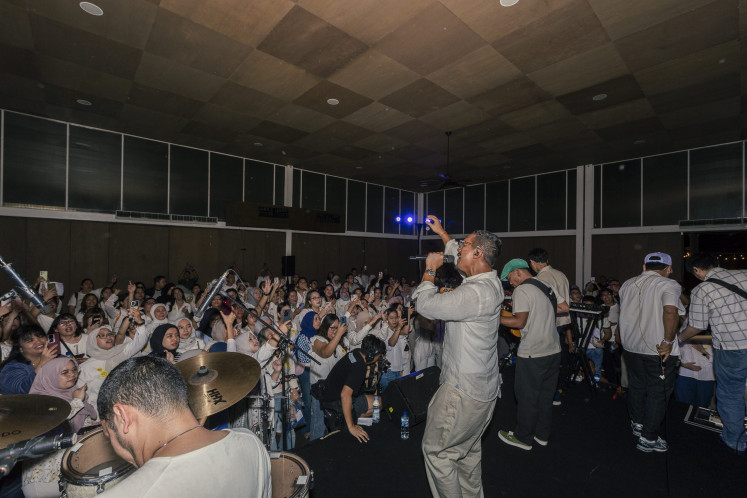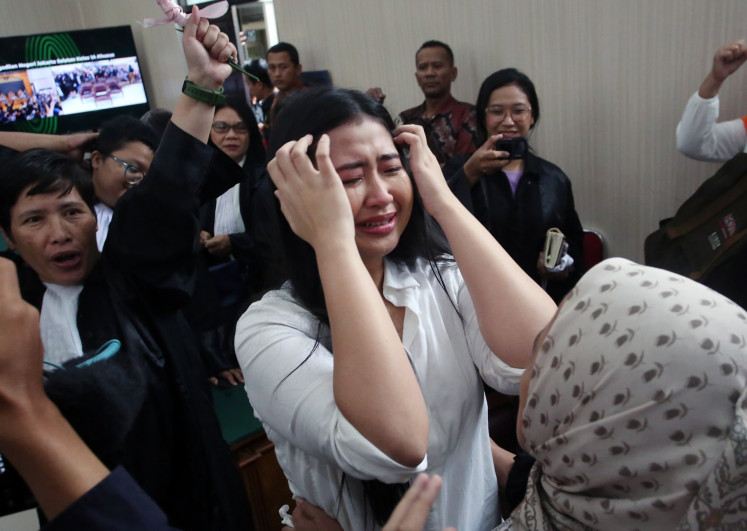Popular Reads
Top Results
Can't find what you're looking for?
View all search resultsPopular Reads
Top Results
Can't find what you're looking for?
View all search resultsReimagining Muara Angke's fishing kampung
Reimagining: Muara Angke Social Housing project constitutes the first of the total of three phases planned in Muara Angke and contains 660 units
Change text size
Gift Premium Articles
to Anyone
R
span class="caption">Reimagining: Muara Angke Social Housing project constitutes the first of the total of three phases planned in Muara Angke and contains 660 units.
An architect couple and their team have taken the best elements of the kampung and implemented them into the housing towers for Muara Angke fishermen in North Jakarta.
The life of a fisherman in Muara Angke, North Jakarta, is not pretty. Houses coexist with piles of garbage that clog sewers. Flooding is part of daily life. The seawater is black and loaded with industrial waste and heavy-metal pollution.
But the fishermen and workers of the fishing industry living there were reluctant to leave the kampung no matter how disorganized and chaotic the environment, as for them the kampung was home ' where they slept, worked, prayed at the adjacent musholla (prayer room), chatted with neighbors or fellow fishermen at nearby kiosks and docked their boats nearby.
From the beginning, SHAU Architecture and Urbanism, which has been entrusted by the Jakarta administration to create the new housing for Muara Angke residents, understood that it would be unwise to uproot them from the kampung life.
Established in 2007, SHAU was founded by Jakarta-born architect Daliana Suryawinata, her husband and working partner Florian Heinzelmann and Tobias Hofmann. It runs offices in Rotterdam, Munich and Bandung.
'We looked at how people live there. It helped us understand the social contacts in Muara Angke,' said Dutch-German architect Heinzelmann.
Muara Angke, as he described, is a mix of lower- and middle-end housing, with some of the area dedicated to fish-related businesses, such as the fish-drying industry.
'It became clear to us that they require not just housing but also a place where they can carry out business. The key is maintaining the kampung life structure and social interactions and dealing with some of its problems, such as lack of hygiene,' he said.
Heinzelmann and his team at SHAU conceived the Muara Angke Vertical Kampung, where the existing kampung structure is maintained and stacked into a vertical neighborhood.
Each floor will be a diverse mix of housing units and public facilities, such as a musholla, small education centers and kiosks. This means a family, for instance, will live on the same floor as a warung and their children will only need to go upstairs to get to their kindergarten.
Each building will have a courtyard to maintain warm interactions among the residents. Meanwhile, the ground floor is intended to facilitate business activities.
SHAU incorporated a series of bioclimatic adaptations to the building design.
'This is a low-tech building, where the residents won't have air conditioning in their units. So, we design to maximize natural lighting, but also protect the building from overheating,' he said.
Vertical kampung: At the base of the design the horizontal spatial organization of a kampung remains, divided into neighborhoods stacked one on top of the other. Between the units, public amenities ' such as playgrounds, kindergartens, prayer rooms, elementary schools and others ' are inserted, contributing to the 'vertical kampung' concept.
To do that, SHAU designed a number of small windows in every unit, with some installed with retractable bamboo shading mats.
The building has a hollow center and void deck to maintain good airflow. Additionally, the building will have a green roof.
Daliana said that the daily activities of the fishermen and fishing industries workers would not change much as the first phase of the housing project was located on a 2.2-hectare plot of land, adjacent to their current kampung and the fish processing unit.
The new housing will also provide facilities and training as part of economic empowerment for the residents.
'On the ground floor, we will have aquaponics for fish culture, workshops on craft and fish products,' she said.
Daliana and her team are mulling a plan to build a canal along the side of the housing so that the fishermen can dock their boats steps away from their dwellings.
'There is a lot of preparation needed for that. We have to coordinate with a number of stakeholders and the city's bureaus, but hopefully we can provide the facility.'
Jakarta Governor Basuki 'Ahok' Tjahja Purnama previously asked property developers seeking to gain permission for coastal reclamation in the city to chip in for the housing project. Agung Podomoro and Jakpro recently confirmed that they would jointly build the housing.
Initiated in 2013, the Muara Angke housing project has made considerably slow progress in two years on account of funding, intra-governmental coordination and mostly Muara Angke people's strong aversion.
'They have been the victims of several evictions since 1960,' Pauline Boedianto, the housing project mediator, said.
'They are distressed to hear the word of Rusun [stacked up residences], which they refer to as being evicted and pushed into an elevated slum.'
Pauline, a Netherlands-educated expert on restoring settlements in rural and urban environments, got involved in the mediation process following violent accidents involving Muara Angke residents in relation to the housing project.
To erase the negative perception toward the project, Pauline started referring to the project as Ikan Mas ' an acronym for Integrasi Kampung Anugrah Nelayan Muara Angke Sejahtera (Blessed Kampung Integration for Prosperous Muara Angke Fishermen).
In cooperation with some firms and charitable organizations, she has held several activities, including free soccer training for Muara Angke children with the players of Jakarta's Persija soccer club.
Now that the housing project's groundbreaking ceremony is nearing, Daliana, Heinzelmann and their team have set another ambitious goal: creating a public beach in Muara Angke. The main hurdle undeniably is the area's infamous polluted water and soil.
'We are keen to have a public beach on the northern side of the housing if there is a concerted effort to clean up the water. Another alternative could be building an artificial beach.'
' Photos courtesy of SHAU Architecture and Urbanism












